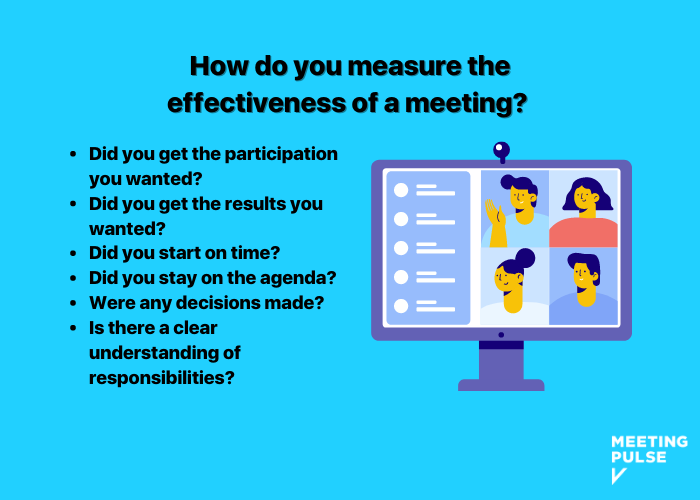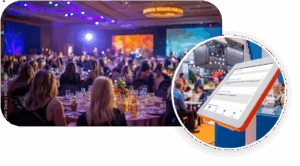If you’ve ever planned a meeting at work, you have likely wondered about meeting effectiveness. After all, businesses spend a lot of time — and money — on meetings, so it’s important to consider how well those meetings are working for you and your team.
One study found that 70% of all meetings keep employees from working and completing their tasks, according to a Harvard Business Review article. *1
Whether you’re gathering to share company-wide information or to hold brainstorming sessions, there’s always a path to holding better meetings. In this article, we will explore why meeting effectiveness is important and describe ways you can measure it to improve future meetings.
Why is meeting effectiveness important?
A roundup of meeting information provides some astounding statistics that can help inform your decisions on planning future meetings. *2
- About 15% of an organization’s time is spent in meetings — a statistic that has increased every year since 2008.
- Employees spend at least four hours a week preparing for all of those meetings.
- On average, each employee attends about 62 meetings a month, and feels that half are a total waste of time.
Inefficient meetings can damage more than a company’s productivity. They also can erode an employee’s mental well-being. The Harvard Business Review cited research that shows that 92% of employees consider meetings costly and unproductive. Too many video meetings can lead to “Zoom fatigue”.
About 78% of participants in one survey found their meeting schedules to be chaotic, and 45% were overwhelmed by the number of meetings on their calendars. That can add up to be a lot of unnecessary stress on employees. But when meetings are well-planned and run properly — and perhaps include perks like free lunch — 64% of employees are more excited about that use of time.
Not all meeting statistics are bad. When a leader uses strong meeting tools and limits the number of meetings, the positive outcomes shine through – and help employees to hold themselves accountable. Meetings give your team a chance to make sure everyone is on the same page. They can help strengthen the relationships between team members. And when run well, they give employees at every level the chance to speak up and be heard.
How do you measure the effectiveness of a meeting?
Before you can evaluate a meeting’s effectiveness and be a true meeting hero, you must know what you’re trying to measure. There are two ways to approach the questions.

What to measure
You’ll need to create some criteria for judging the success of a meeting, including:
- Did you get the participation you wanted? After the meeting, think about whether employees spoke up. Were their comments helpful or did they hinder conversation? How many people spoke up in comparison to how many attended? Did the meeting have full participation or was communication at a minimum with few dominant voices?
- Did you get the results you wanted? When you decided to hold the meeting, what outcome did you want? Was your goal achieved or did the meeting fall short? Did the meeting fulfill the original purpose?
- Did you start on time? It’s important to respect your team’s time and get the meeting rolling on schedule. Were you able to get going at the meeting start time?
- Did you stay on the agenda? Think back to the flow of the meeting and whether you stayed the course or if conversation went off the rails.
- Were any decisions made? If part of your goal was to make decisions, were those made? If not, why not?
- Is there a clear understanding of responsibilities? When the meeting wrapped up, did your team understand any shifts or changes in responsibilities, projects, timelines or other important agenda items? In other words, is everyone clear on who is doing what, and when the work is due?
- Were the right people in the meeting – and the rest allowed to work? In post-meeting evaluations, it’s a good idea to ask participants if they thought their time was well used. Were they necessary to the meeting? Could they have, instead, watched the video (perhaps at a higher speed), or attended only part of the meeting?
How to measure
Fortunately, there are several simple methods for meeting evaluation. For each one, stay open to the idea of follow up questions and asking your team to provide feedback so you can get better results at your next meeting.
Survey attendees
This is a bit of a no-brainer, but ask meeting attendees for feedback after a meeting has ended to evaluate its effectiveness and whether it’s valuable enough to keep on the calendar.
MeetingPulse provides a wide range of tools for getting instant feedback and valuable data from meeting participants. Its surveys and live polls give employees a chance to weigh in on key topics, whether the meeting is in-person, virtual or a hybrid. Anonymity features also ease anxieties that might cause employees to hold back. Everyone can enjoy the live polls and take part in interactive experiences.
You could develop a standard survey to send to attendees, including questions similar to the list in the previous section above, and add specific questions related to your team’s use of time or functions.
Another method is to use a letter grade system. With this option, ask your team to grade each meeting with a letter — similar to the good old days when you received a report card at school. Use a wide range, like A to F, and ask respondents to give you one or two reasons why they graded the meeting the way they did. Making the feedback anonymous can solicit more honest feedback, but give your team the ability to put their name on their feedback if they wish, because it’s an opportunity to give voice to people who might not otherwise have the opportunity.
After hosting thousands of meetings and events, we’ve found that organizers are much more likely to get meeting engagement and buy-in if they crowdsource the agenda, and better meeting feedback if they offer a way for attendees to give it during the event – not after it’s over.
Self-evaluations
One of the easiest ways to measure your meeting’s effectiveness is to evaluate your own sessions as a meeting leader. Develop evaluation questions based on the above list of what to measure and then use it after each meeting.
Meeting audits
When you look at your monthly meeting calendar, make a list of which meetings are recurring, how often they take place and how much time is allotted for each. Consider how many people are invited to each meeting, how many people RSVP and attend, whether there is an agenda shared with the invitees and if meeting notes are shared with attendees once the meeting is over.
According to the Harvard Business Review research on 76 companies, employee productivity was 71% higher when meetings dropped by 40%.
Based on the insights gained, ask whether each specific type of meeting is taking place too often or just enough, if each meeting regularly achieves its goal, or if there are ways to improve the meeting or, if need be, turn it into a quick check-in via team email or other form of communication. Share your findings with your teammates — they might have some insight you overlooked or other feedback to offer.
Wiping the calendar clean
If you’re looking for a serious meeting overhaul, one quick way to achieve it is to cancel all of your existing meetings and add back only the most essential ones. When you’re considering whether to revive a meeting, be incredibly selective about doing so. Be sure to ask yourself — and your team — if there is another way to communicate any relevant needs or information.
Conclusion
As we’ve detailed, you can easily evaluate the effectiveness of your meetings using any of the methods listed above. It’s important to make sure you’re making the best of everyone’s time and energy. In addition, MeetingPulse offers many tools to help you gauge the meetings on your calendar and how to make each and every meeting better.









